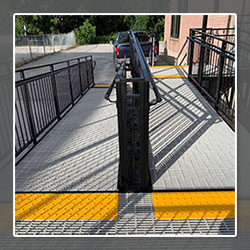









Ensuring accessibility for all individuals, regardless of physical ability, is a crucial moral and legal responsibility. For visually impaired persons, in particular, navigating the built environment poses daily challenges that most sighted individuals take for granted.
Tactile warning surface indicators (TWSIs), also known as detectable warning surfaces, provide a vital communication channel between public infrastructure and individuals with visual disabilities. Composed of standardized textured ground surfaces, TWSIs convey essential information non-visually through the sense of touch.
As per Canadian accessibility legislation like the Accessibility for Ontarians with Disabilities Act (AODA), integrating TWSIs in various indoor and outdoor public spaces is mandatory. When thoughtfully implemented, these ingenious surfaces enhance accessibility and quality of life for millions of Canadians.
TWSIs feature distinctive surface patterns that are easily detectable underfoot or by a cane. Two main types exist:
These indicate potential hazards like the edge of a platform or oncoming vehicular traffic. The typical configuration is truncated domes organized in a square or radial pattern.
These provide directional cues to guide pedestrians along designated walking paths. Common configurations are raised bars, cones, or grooves running parallel to the direction of travel.
The thoughtful integration of TWSIs enhances indoor accessibility and safety for the visually impaired. Key applications include:
Proper interior placement is crucial - too few can leave dangerous gaps in information, while overuse can cause clutter and confusion. When thoughtfully distributed, indoor TWSIs foster confidence, independence, and security.
Outdoor public realms present even greater navigational challenges. Proper TWSI integration enhances outdoor accessibility by:
With outdoor TWSIs, regular maintenance is key, as exposure can degrade materials over time. Fortunately, their durable materials offer excellent longevity even in harsh conditions.
The benefits of thoughtfully installed TWSIs for visually impaired Canadians are immense, including:
Ultimately, TWSIs allow full participation in society and provide a lifeline to accessibility.
Beyond the user perspective, TWSIs also benefit the owners and operators of public and private spaces in key ways:
By investing in proper TWSI integration, organizations show they genuinely care about inclusivity - an ethos that appeals to conscientious consumers.
To maximize the benefits of TWSIs for all, consider the best practices:
With thoughtful design, diligent installation, and proper maintenance, the impacts of TWSIs on accessibility and inclusivity will continue growing for decades to come.
Tactile ground surface indicators provide detectable tactile cues to assist visually impaired pedestrians in navigating public spaces safely and independently. Key purposes include signaling hazards and providing directional guidance.
These textured ground surface indicators serve two main functions - warning pedestrians about upcoming hazards like curbs or stairs and guiding pedestrians along designated walking paths in large open spaces.
Warning tactile ground surface indicators use distinctive surface patterns like truncated domes to signal upcoming hazards to pedestrians with visual disabilities. This alerts them to dangers like curbs, platform edges, vehicle areas, or stairs.
In our complex urban landscapes, seamless public accessibility requires careful infrastructural planning. For pedestrians with visual impairments, the integration of Tactile Warning Surface Indicators (TWSIssss) provides an indispensable communication channel to the built environment. Indoors and out, proper TWSIs placement promotes confidence, independence, and security during daily life.
By investing in compliant, durable, thoughtfully distributed TWSIs, businesses and urban planners take an essential step towards a Canada without barriers. At Tactile Solution, we provide reliable, superior-quality TWSIs not only meet but surpass all pertinent regulations and specifications. We offer a variety of colors, shapes, and sizes to meet the specific needs of each project.
